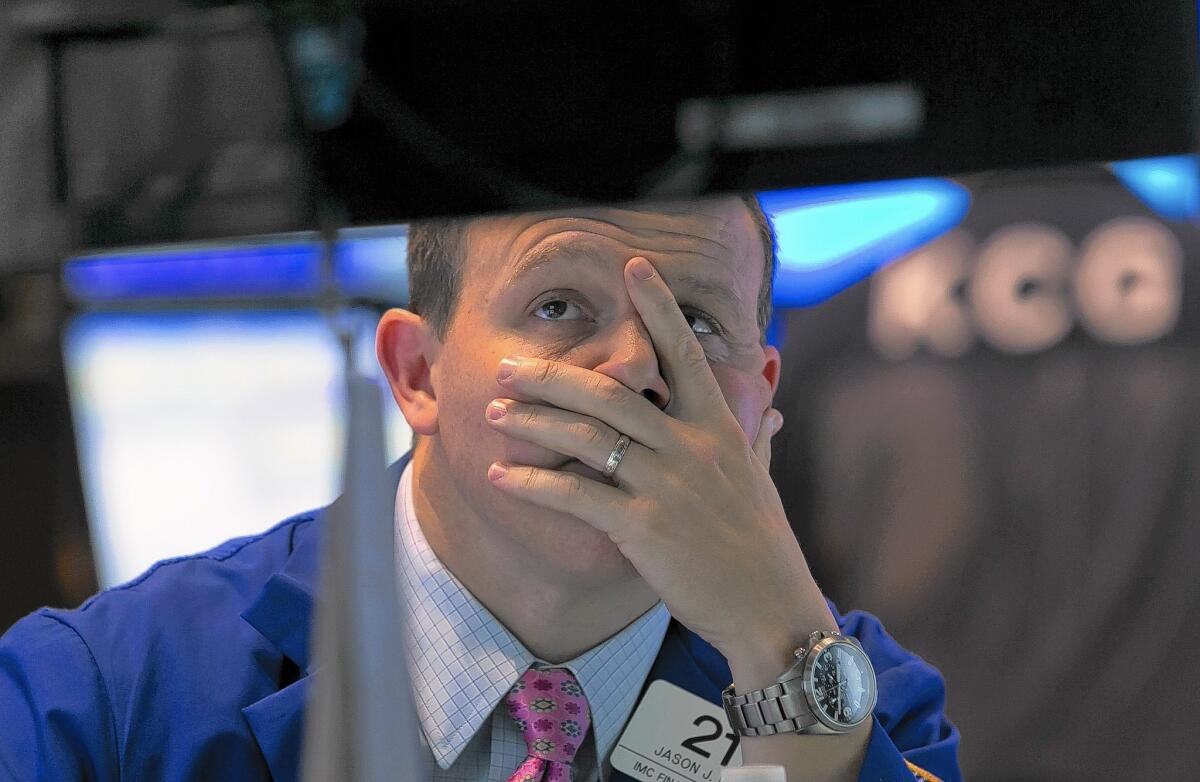Stocks fall on fears of weakness abroad

- Share via
It was the steepest of roller-coaster rides for investors this week, and it ended with a 115-point drop in the Dow Jones industrial average that wiped out the year’s gains for the benchmark index.
Throughout the nation and worldwide, major indexes fell Friday, mostly on concerns of a weakening European economy and slowing growth in China.
Fundamentally, the U.S. picture remained unchanged, and fairly positive. Corporate earnings, for instance, haven’t shown particular weakness, analysts said.
But, they said, investors are concerned about the disconnect between a strengthening U.S. economy and the darkening economic situation in Europe and elsewhere that could pull the U.S. down.
The push-me-pull-you struggle — where both economic growth and sluggishness are seen as risks to markets — has preyed on investor confidence and caused many to pull back on stocks, at least for the time being.
“The macroeconomic landscape is changing rapidly for investors,” said analyst Robert Keiser of the Global Markets Intelligence Unit of S&P Capital IQ. “A year ago, we anticipated a healthy economic recovery for Europe.... It looks to me that this is nothing more than a bit of macroeconomic indigestion for investors.”
The pullback was felt across the board, affecting all sectors, corporations large and small, both here and abroad.
After its biggest one-day rally of the year with a 275-point gain Wednesday, the Dow had its biggest one-day drop of the year with a 355-point slide Thursday.
On Friday, it dropped 115.15, or 0.7%, to 16,544.10, leaving the blue-chip index down 0.2% for the year. It has plunged 2.7% this week and 2.9% so far this month.
The broader S&P 500 index slipped 22.08, or 1.2%, to 1906.13. It has fallen 3.1% this week and 3.4% so far this month but is holding on to now-modest gains of 3.1% for the year.
The biggest loser was the technology-laden Nasdaq composite index, which lost 102.10 points Friday, or 2.3%, to 4,276,24. The Nasdaq dropped 4.5% this week and 4.8% so far this month. For the year, however, the index is still up 2.4%.
Smaller companies represented in the Russell 2000 index didn’t fare any better. That index dropped 1.4% on Friday in what analysts said was a sign of investor anxiety over whether U.S. employers can continue creating 200,000 jobs a month.
European exchanges were also down sharply Friday with the FTSE 100 in London falling 0.78%, the French CAC 40 off 1.6% and the German DAX losing 2.4% on concerns that Germany, heretofore the bulwark of the European economy, might be faltering, too, in the wake of political tensions with Russia and falling trade with Eastern Europe.
Although the U.S. economy has been gaining some traction, it is dogged by worries about the still-fragile and economically vital housing sector.
The PHLX housing index of 70 home builders, suppliers and other housing-related stocks closed down 2% on the day and is off 10.1% for the year, making it one of the hardest-hit sectors.
John Lonski, chief capital markets economist at Moody’s Analytics, said the sector’s performance seems to argue against the Federal Reserve raising near-zero interest rates any time soon and in favor of sending more calming signals to the markets to help bring mortgage rates down and give the sector a boost.
“One way to conquer this type of uncertainty is through an unexpected decline by bond yields,” he said.
Indeed, part of the new volatility in equity markets can be traced to uncertainty over the direction of the Federal Reserve, which has assumed ever-larger importance in financial markets as fiscal policy has been stymied by political gridlock in Washington.
The increasingly robust debate among Fed hawks and doves — those policymakers who want to raise interest rates soon and those who still see lower rates as necessary to boost growth — is healthy in that it adds a degree of transparency to the central bank’s intentions, analysts said, but it generates uncertainty as well.
“I don’t think there’s a lack of clarity,” Keiser said. “There’s a big disagreement right now between the doves who seem to be controlling the debate and the hawks who are very vocal.”
Investors can take a degree of comfort in the fact that share prices as a function of real-world profits are not especially high by historical standards.
The Dow’s price-to-earnings ratio fell back Friday to under 16 times earnings, about where it was a year ago. The recent pullback in share prices might be enough to attract investors back into the market, analysts said.
More to Read
Inside the business of entertainment
The Wide Shot brings you news, analysis and insights on everything from streaming wars to production — and what it all means for the future.
You may occasionally receive promotional content from the Los Angeles Times.











